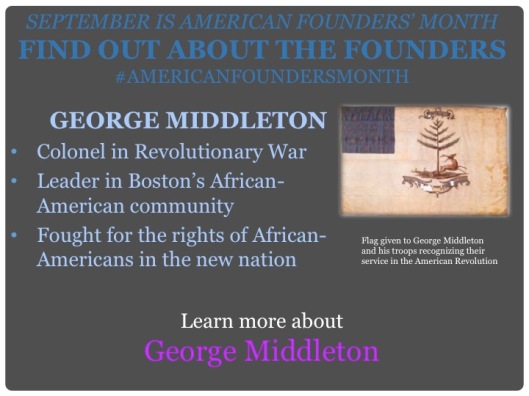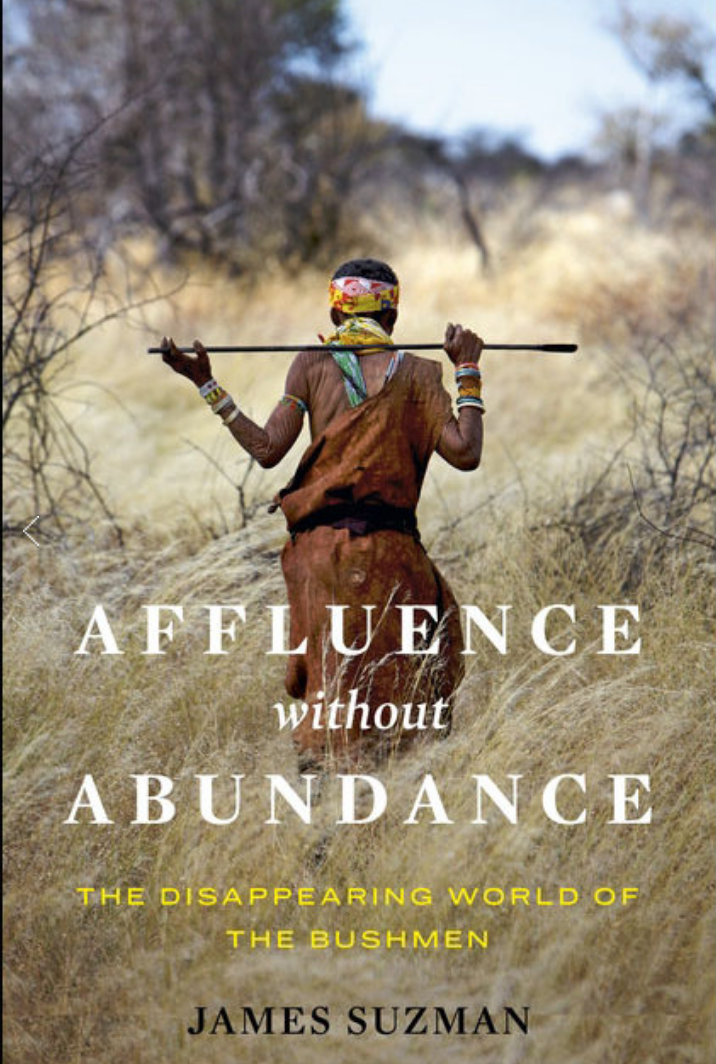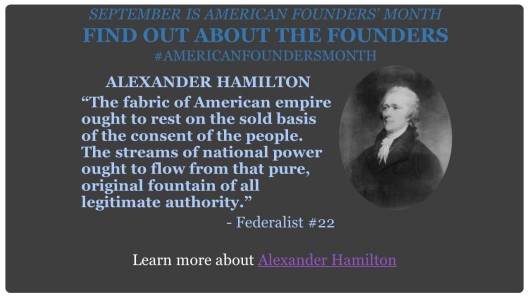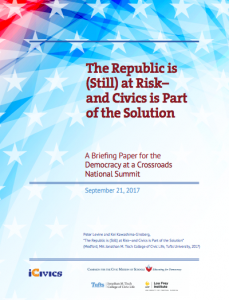Monthly Archives: September 2017
Neighbourhood Management
Method: Neighbourhood Management
Neighbourhood Management
Method: Neighbourhood Management
American Founders’ Month in Florida: George Middleton

American Founders’ Month in Florida continues! Today, we will meet George Middleton. Colonel Middleton was one of the leaders of the African-American community in Revolutionary-era Boston, and helped established a predominately African-American militia during the war. This militia, known as ‘The Protectors’, helped defend property and people in Massachusetts throughout the war.
Colonel Middleton was also a strong advocate for the rights of African-Americans in the new United States. Whether fighting against slavery and for civil and political rights or equal opportunities for education for African-American children, Middleton is a role a model for citizens in the nation, then and now.
“Freedom is desirable, if not, would men sacrifice their time, their property and finally their lives in the pursuit of this?”
Middleton’s words ring true today. As we enter Freedom Week, it is important that we remember and recognize all of those that have lived those words throughout our history.
You can learn more about George Middleton from the National Park Service and see his home if you visit the Black Heritage Trail in Boston!
Grab the PowerPoint slide at the top of this post here: George Middleton AFM
Additional entries in the American Founders’ Month series:
Introduction to the Founding Fathers
Who Was George Washington?
Abigail Adams: Founding Mother and so much more
John Adams: A Hero of Liberty
James Madison: Father of the Constitution
The Sons of Liberty: The Tea Party and More
Mercy Otis Warren: Antifederalist and Advocate for Liberty
Alexander Hamilton: More Than a Musical
Tufts Political Theory Workshop
(Please contact me if you would like to attend.)
September 28th and 29th at Fung House. 48 Professors Row, Tufts Campus, Medford MA
Thursday Sept. 28
5 pm “(Un)equal Respect and Agents of Justice”
Benedetta Giovanola, Associate Professor of Moral Philosophy
Department of Political Science, Communication, and International Relations, University of Mascerata, Italy Commentator: Dennis Rasmussen, Associate Professor of Political Science
6:15 pm “The Nature and Design of Robust Institutions”
Speaker: Brian Epstein, Associate Professor of Philosophy
Commentator: Peter Levine, Lincoln-Filene Professor of Citizenship and Public Affairs Jonathan M. Tisch College of Civic Life
7:30 pm Dinner for all participants
Friday, Sept. 29th
9:00 am “Justice, Self-Sufficiency, and Commodious Living: Hobbes’ s Commercial Republic”
Speaker: loannis Evrigenis, Professor of Political Science Commentator: Vickie Sullivan, Professor of Political Science
10:15 am “Grounds for Coverage: Considering the Basis for Entitlements of Immigrants to Health Care”
Speaker: Keren Ladin, Assistant Professor of Public Health and Community Medicine and Occupational Therapy
Commentator: Alecia McGregor, Assistant Professor of Community Health
11:30 am “We, the Mediated People: Unconventional Adaptation in post-Cold War South America”
Speaker: Joshua Braver, Jonathan M. Tisch Post-doctoral Fellow in Political Science Commentator: Abiodun Williams, Director, The Institute for Global Leadership
12:30 pm . Lunch
Sponsored by the Tufts Department of Philosophy, the Department of Political Science, and the Jonathan M. Tisch College of Civic Life
Gender and Language
Both gender and language are social constructs, and sociological research indicates a link between the two.
In Lakoff’s classic 1973 paper, Language and woman’s place, she argues that “the marginality and powerlessness of women is reflected in both the ways women are expected to speak, and the ways in which women are spoken of.” This socialization process achieves its end in two ways: teaching women the ‘proper’ way to speak while simultaneously marginalizing the voices of women who refuse to follow the linguistic norms dictated by society. As Lakoff writes:
So a girl is damned if she does, damned if she doesn’t. If she refuses to talk like a lady, she is ridiculed and subjected to criticism as unfeminine; if she does learn, she is ridiculed as unable to think clearly, unable to take part in a serious discussion: in some sense, as less than fully human. These two choices which a woman has – to be less than a woman or less than person – are highly painful.
Lakoff finds numerous lexical and syntactic differences between the speech of men and women. Women tend to use softer, more ‘polite’ language and are more like to hedge or otherwise express uncertainty with in their comments. While she acknowledges that – as of the early 70s – these distinctions have begun to blur, Lakoff also notes that the blurring comes almost entirely in the direction of “women speaking more like men.” Eg, language is still gendered, but has acceptable language grown in breadth for women, while ‘male’ language remains narrow and continues to be taken as the norm.
A more recent study by Sarawgi et al looks more closely at algorithmic approaches to identifying gender. They present a comparative study using both blog posts and scientific papers, examining techniques which learn syntactic structure (using a context-free grammar), lexis-syntatic patterns (using n-grams), and morphological patterns using character-level n-grams.
Sarawgi et al further argue that previous studies made the gender-identification task easier by neglecting to account for possible topic bias, and they therefore carefully curate a dataset of topic-balanced corpora. Additionally, their model allows for any gamma number of genders, but the authors reasonably restrict this initial analysis to the simpler binary classification task, selecting only authors who fit a woman/man gender dichotomy.
Lakoff’s work suggests that there will be lexical and syntactic differences by gender, but surprisingly, Sarawgi et al find that the character-level n-gram model outperformed the other approaches.
This, along with the fact that the finding holds in both formal and informal writing, seems to suggest that gender-socialized language may be more subtle and profound than previously thought. It is not just about word choice or sentence structure, it is more deeply about the very sounds and rhythm of speech.
The character n-gram approach used by Sarawgi is taken from an earlier paper by Peng et al which uses character n-grams for the more specific task of author attribution. They test their model on English, Greek, and Chinese corpora, achieving impressive accuracy on each. For the English corpus, they are able to correctly identify the author of text 98% of the time, using a 6-gram character model.
Peng et al make an interesting case for the value of character n-grams over word n-grams, writing:
The benefits of the character-level model in the context of author attribution are that it avoids the need for explicit word segmentation in the case of Asian languages, it captures important morphological properties of an author’s writing, it can still discover useful inter-word and inter-phrase features, and it greatly reduces the sparse data problems associated with large vocabulary models.
While I initially found it surprising that a character level n-gram approach would perform best at the task of gender classification, the Peng et al paper seems to shed computation light on this question – though the area is still under theorized. If character n-grams are able to so accurately identify the single author of a document, and that author has a gender, it seems reasonable that this approach would be able to infer the gender of an author.
Still, the effectiveness of character n-grams in identifying an author’s gender indicates an interesting depth to the gendered patterns of language. Even as acceptable language for women converges to the acceptable language of men, the subtleties of style and usage remain almost subconsciously gendered – even in formal writing.
Affluence Without Abundance: What Moderns Might Learn from the Bushmen
Where did things go wrong on the way to modern life, and what should we do instead? This question always seems to lurk in the background of our fascination with many indigenous cultures. The modern world of global commerce, technologies and countless things has not delivered on the leisure and personal satisfaction once promised. Which may be why we moderns continue to look with fascination at those cultures that have persisted over millennia, who thrive on a different sense of time, connection with the Earth, and social relatedness.
Such curiosity led me to a wonderful new book by anthropologist James Suzman, Affluence without Abundance: The Disappearing World of the Bushmen. The title speaks to a timely concern: Can the history of Bushmen culture offer insights into how we of the Anthropocene might build a more sustainable, satisfying life in harmony with nature?
Writing with the emotional insight and subtlety of a novelist, Suzman indirectly explores this theme by telling the history and contemporary lives of the San – the Bushmen – of the Kalahari Desert in Africa. The history is not told as a didactic lesson, but merely as a fascinating account of how humans have organized their lives in different, more stable, and arguably happier, ways. The book is serious anthropology blended with memoir, political history, and storytelling.
After spending 25 years studying every major Bushman group, Suzman has plenty of firsthand experiences and friendships among the San to draw upon. In the process, he also makes many astute observations about anthropology’s fraught relationship to the San. Anthropologists have often imported their colonial prejudices and modern alienation in writing about the San, sometimes projecting romanticized visions of “primitive affluence.”
Even with these caveats, it seems important to study the San and learn from them because, as Suzman puts it, “The story of southern Africa’s Bushmen encapsulates the history of modern Homo sapiens from our species’ first emergence in sub-Saharan Africa through to the agricultural revolution and beyond.” Reconstructing the San’s 200,000-year history, Suzman explains the logic and social dynamics of the hunter-gatherer way of life -- and the complications that ensued when agriculture was discovered, and more recently, from the massive disruptions that modern imperialists and market culture have inflicted.
The fate of one band of San, the Ju/’hoansi, is remarkable, writes Suzman, because the speed of their transformation “from an isolated group of closely related hunting and gathering bands to a marginalized minority struggling to survive in a rapidly changing polyglot modern state is almost without parallel in modern history.” As European settlers seized their land, forced them to give up hunting, forced them to become wage-laborers on farms, and introduced them to electricity, cars and cell phones, the Ju/’hoansi acquired “a special, if ephemeral, double perspective on the modern world – one that comes from being in one world but of another; from being part of a modern nation-state yet simultaneously excluded from full participation in it; and fro having to engage with modernity with the hands and hearts of hunter-gatherers.”
In learning more about the San, then, one can learn more about the strange, unexamined norms of modern, technological society that most of us live in. It is fascinating to see the social protocols of sharing meat and food; the conspicuous modesty of successful hunters (because in the end their success is part of a collaboration); and the “demand sharing” initiated by kin and friends to ensure a more equal distribution of meat and satisfaction of basic needs.
The inner lives of the Ju/’hoansi suggests their very different view of the world. “For them,” writes Suzman, “empathy with animals was not a question of focusing on an animal’s humanlike characteristics but on assuming the whole perspective of the animal." The performance of the hunt engenders a kind of empathy for the prey, as well as a broader understanding that the cosmos ordains certain sacred roles for all of us – as prey, hunters, and food. Hunting and eating in the Kalahari connects a person with the cosmos in quite visceral ways – something that no supermarket can begin to approach.
I’m not ready to hunt my own food, but is there some way that I can see my bodily nourishment reconnected with the Earth and my peers, and not just to packaged commodities? For now, my CSA is a good start.
The most poignant part of Affluence without Abundance is the final chapter, which describes how many San – deprived of their lands, ancestral traditions, and cultural identities – now live out dislocated lives in apartheid-founded townships that Suzman characterizes as having a “curious mix of authoritarian order and dystopian energy.” There is deep resentment among the San about the plentitude of food even as people go hungry, and anger about the inequality of wealth and concentration of political power. Most frightening of all may be the pervasive feelings of impermance and insecurity. History barely matters, and the future is defined by market-based aspirations -- a job, a car, a home. The modern world has few places to carry on meaningful traditions and sacred relationships.
I was pleased to see that James Suzman has founded a group, Anthropos, https://www.anthropos.org.uk/about to “apply anthropological methods to solving contemporary social economic and development problems.” A timely and important mission.
Apply to Host a Nevins Fellow – Deadline October 23!
NCDD was happy to host a Confab Call this week with our partners at the McCourtney Institute for Democracy – an NCDD member organization – who talked about the incredible opportunity for D&D organizations to take advantage of their Nevins Democracy Leaders Program. Nearly two dozen organizations participated in the call, which marked the launch of the 2017-18 application for organizations who want to host a bright, motivated, D&D-trained student who will work with their organization for eight weeks next summer at no cost.

We are encouraging our member organizations to apply today for the chance to host a Nevins Fellow next summer! Having a Nevins Fellow work with you is like bringing on a new full-time staffer, so it’s a great way for your organization to finally take on a special project you haven’t had time for, get extra help with your big summer engagements, or increase your organizational capacity overall – all while helping bring more young people into our field and growing the next generation of D&D leaders!
Opportunities like this don’t come often or last long, so we encourage you to make sure to apply for a Nevins Fellow before the October 23rd deadline. You can find the application at http://tinyurl.com/Nevins2017.
If you haven’t heard of the Nevins program before, or are looking for a little more information, you are in luck!. You can start with the Frequently Asked Questions document that McCourtney created for potential applicants. We also had an informative discussion on the Confab Call with Chris Beem from the McCourtney Institute, who covered lots of the important details about the program, and you can listen to the recording of that call by clicking here. You can also get a better sense of what the program experience is like from the student’s perspective by checking out this blog post from a 2017 Nevins Fellow about their summer fellowship with the the Jefferson Center.
We can’t speak highly enough about the Nevins program’s students who applicants will have the chance to work with or about the value of this program’s contributions to the D&D field. We know that these young people will add enormously to the organizations they work with and that this program is helping secure the future of our field – a wonderful testament to vision of the program founder and NCDD member David Nevins. We encourage you to apply today!
new overview of civic education
I’m at Democracy at the Crossroads, a conference on civic education, with speakers who include Justice Sonia Sotomayor, former Secretary of Education John B. King Jr., Senator Bob Graham, Prof. Danielle Allen, and more. At this conference, we are releasing “The Republic is (Still) at Risk–and Civics is Part of the Solution.” Kei Kawashima-Ginsberg and I are the authors of this new overview document, which builds on The Civic Mission of Schools (2003) and Guardians of Democracy (2011). We argue that the main reason to strengthen civics is the perilous condition of our republic, that today’s circumstances require innovation (not your grandparents’ civics), that a wide range of practices are effective when done well, and that state policies can support civics. The paper releases new information on positive changes in Florida and Illinois. It is available for download.
Citation: Peter Levine and Kei Kawashima-Ginsberg, “The Republic is (Still) at Risk—and Civics is Part of the Solution” (Medford, MA: Jonathan M. Tisch College of Civic Life, Tufts University, 2017)
American Founders’ Month in Florida: Alexander Hamilton

It’s American Founders’ Month in Florida, and today we look at Alexander Hamilton. Hamilton, one of the youngest of those men and women so significant in the early life of the United States, has certainly experienced something of a renaissance lately. This is due in no small part to the wonderful work of Lin Manuel Miranda and his musical interpretation of Hamilton’s life and career. But did you know that this great musical is actually based on a fantastic historical book about this immigrant and leader? It draws from the work of historian Ron Chernow, and has inspired many Americans, young and old, to consider anew the life and beliefs of this sometimes controversial Founding Father.
Alexander Hamilton was many things. An intellectual, a Federalist, an immigrant, the father, and even savior, of the American economy, Treasury Secretary, an advocate for an aggressively strong federal government, an effective national bank, and ultimately a man who had as many enemies as he did friends. You can learn more about Hamilton from the New York Historical Society.
Grab the PowerPoint slide featured in this post: Alexander Hamilton AMF
Check out Lin Manuel Miranda performing one of the best songs from his impactful musical.
Additional entries in the American Founders’ Month series:
Introduction to the Founding Fathers
Who Was George Washington?
Abigail Adams: Founding Mother and so much more
John Adams: A Hero of Liberty
James Madison: Father of the Constitution
The Sons of Liberty: The Tea Party and More
Mercy Otis Warren: Antifederalist and Advocate for Liberty

